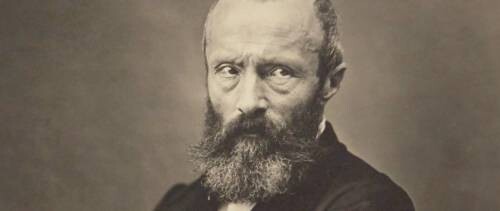He was a revolutionary in art criticism and played a crucial role in the rediscovery and revaluation of artists who had long been forgotten.
Radical art lover
Born in 1807 in La Flèche, France, Thoré-Bürger was politically and socially engaged from an early age. He was a staunch republican and a fierce opponent of Napoleon III's authoritarian regime. His political convictions led to his exile in the 1850s, a period during which he lived in Belgium and the Netherlands. It was also during this period that he adopted the Dutch-sounding pseudonym Willem Bürger, under which he published his work. Paradoxically, this exile proved to be a fruitful period for his intellectual development.
The rediscoverer of the Dutch masters
It was during his stay in the Low Countries that Thoré-Bürger developed a deep fascination for 17th-century Dutch and Flemish art. He was not a man of traditional art history; he sought out the human and social aspects in the paintings he studied. He admired the realistic depiction of everyday life and the psychological depth of the portraits.
In his articles, he wrote with infectious enthusiasm about artists who were considered inferior or “second-rate” by traditional art critics. He was an ardent admirer of Jan van Goyen, Meindert Hobbema, and especially Johannes Vermeer.
Johannes Vermeer: The rediscovery
Vermeer, who was largely unknown in the nineteenth century, was claimed by Thoré-Bürger to be one of the greatest painters of all time. He was fascinated by the masterful control of light and shadow, the tranquil intimacy of the scenes, and the inimitable quality of the paint.
Thoré-Bürger's fascination with Vermeer was aroused when he saw View of Delft at the Mauritshuis in The Hague in 1842. At the time, Vermeer's name was known only to a small circle of people, but Thoré-Bürger was so fascinated that he embarked on a systematic search for Vermeer's works in the years leading up to his exile.
In the 1860s, Thoré bought his first Vermeer, Woman Playing the Virginal, now on display at the National Gallery in London. In June 1866, the French painter, draughtsman and lithographer Henry Grevedon sold Thoré-Bürger Woman with a Pearl Necklace, now on display at the Gemäldegalerie in Berlin. In 1867, Thoré-Bürger paid 2,000 francs for The Seated Virginal Player. It is not known from whom he purchased this work. The Seated Virginal Player has been in the possession of The National Gallery in London since 1910.
Théophile Thoré-Bürger died in 1869, but his extensive art collection remained in the possession of his family, particularly the Lacroix family. It was not until 23 years after his death, on 5 December 1892, that the collection was auctioned at the Hôtel Drouot in Paris. The auction catalogue provided an overview of the treasures Thoré-Bürger had collected during his lifetime. The collection consisted of 59 paintings, including masterpieces by his beloved 17th-century Dutch masters. However, the most striking part of the auction was the presence of several works by Johannes Vermeer, the artist whom Thoré-Bürger had single-handedly rescued from obscurity.
The culmination of a life's work
The auction marked a crucial moment in the reappraisal of Vermeer. Whereas Thoré-Bürger had promoted Vermeer during his lifetime, the auction ensured that Vermeer's works finally gained a place on the international art market. The paintings that changed hands during the auction included:
- The Concert: This painting was purchased by American collector Isabella Stewart Gardner. The canvas was stolen from the Isabella Stewart Gardner Museum in Boston in 1990 and has still not been found.
- Seated Virginal Player: This work was purchased for 25,000 francs by Charles Sedelmeyer and is now in the National Gallery in London.
- Standing Virginal Player: This painting was also purchased by the National Gallery in London.
The auction was a financial success and highlighted the enormous increase in value of the artists that Thoré-Bürger had discovered and promoted. The auction of Thoré-Bürger's collection in 1892 was also the culmination of a life's work. It ensured that the works of Vermeer and other masters ended up in leading museums around the world, making them accessible to the general public.
The next time you stand in front of a Vermeer, remember that you owe this in part to a radical, exiled art critic who had the courage to swim against the tide and see the beauty that others overlooked.
-en.webp)
